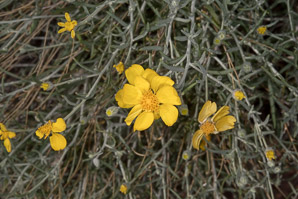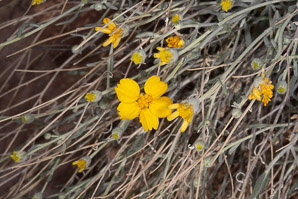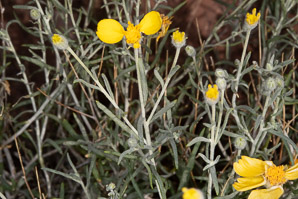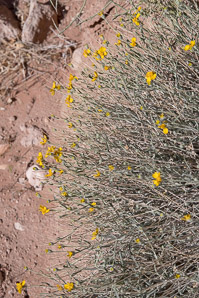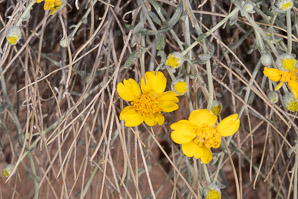
|
Baileya pauciradiata Harv. & A. Gray ex A. Gray Laxflower, Colorado desert marigold, Colorodo Desert Marigold
Laxflower is native to northern Mexico and the southwestern United States, at elevations of less than 3000′ (914 m). It prefers sandy habitats and full sun. Plants: 4-20″ (10-50 cm), often branched. Stems are silvery (tomentose) due to the presence of many tiny hairs. Leaves: Basal leaves wither quickly. Leaves higher up are 1½-6″ (4-14 cm) long, linear-oblong to lanceolate or oblanceolate, sometimes deeply lobed. Flowers: Composite flowers are yellow. Each stem contains 2-3 flowers. Each flower contains 4-8 obovate rays, each with 3 shallow lobes, yellow or pale yellow. There are 8-20 disc flowers, also yellow, and hairy. Flowers appear from March to May. Fruits: Club-shaped, ⅛-3/16″ (4-5 mm), evenly ribbed. Medical: Contains odoratin and paucin, which may prove effective against certain cancers. Online References:
CalPhotos (photos) Www.sciencedirect.com (paywalled) 4/29/2018 · Red Spring Calico Basin, Red Rock Canyon, Nevada · ≈ 7 × 4½″ (18 × 12 cm)
Baileya pauciradiata description by Thomas H. Kent, last updated 25 May 2020. © FloraFinder.org. All rights reserved. |
4/29/2018 · Red Spring Calico Basin, Red Rock Canyon, Nevada · ≈ 6 × 4″ (15 × 10 cm) 4/29/2018 · Red Spring Calico Basin, Red Rock Canyon, Nevada · ≈ 4 × 6″ (11 × 16 cm) 4/29/2018 · Red Spring Calico Basin, Red Rock Canyon, Nevada · ≈ 1 × 1½′ (34 × 52 cm) 4/29/2018 · Red Spring Calico Basin, Red Rock Canyon, Nevada · ≈ 6 × 4″ (14 × 10 cm) Range:
|
